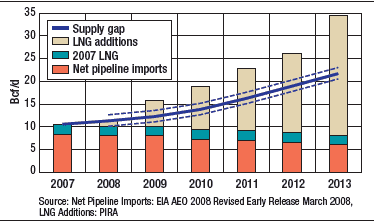By David Michael Cohen
Importation of liquefied natural gas (LNG) will be increasingly important to meet US energy demands as domestic production becomes more difficult and Alberta’s oil sands divert gas imports from Canada, an LNG expert argued on the last day of OTC.
Davis Thames, senior vice president of marketing for LNG receiving company Cheniere Energy, presented his analysis on the interaction between multiplying LNG regasification projects in the US and the North American gas market at an OTC luncheon. The US has seven operating LNG regasification terminals, including Cheniere’s new Sabine Pass facility, which received its first shipment on April 11, 2008. Twenty additional plants and expansions have been approved for construction by the Federal Energy Regulatory Commission and the Coast Guard.
“LNG has certainly been a part of our supply mix for many years, but as we are continuing to see the need for growing imports from LNG, you’re going to find more and more of these assets are deployed around the country,” Thames said.
 |
|
Davis Thames of Cheniere Energy.
|
|
|
Imports will have to increase because shale and other unconventional gas plays will not be able to meet rising US gas demand, Thames said, pointing out that the US gas rig count has steadily increased by about 15-20% per year for the last five years, while production has stayed relatively flat at 50 Bcfd.
“It’s not only that it’s technically challenging to drill; it’s also very expensive to build the pipelines and the gas treatment plants and to go through peoples’ pristine Colorado ranches to get the gas back to a reasonable market,” he said.
Thames acknowledged that his gas demand predictions conflicted with a recent long-term energy outlook report by the US Energy Information Administration, which shows natural gas leveling out and coal increasing as sources of electric generation. Power generation was the main driver of a huge 6.2% annual increase in US gas consumption in 2007. Thames said the EIA’s prediction is unlikely, given the bipartisan support for carbon legislation and widespread public opposition to coal-fired plants. He referred to about 5,500 MW of proposed coal-fired plant capacity in the Southeast that has been cancelled within the last year or so.
Another factor he said will favor gas is the smaller scale and proximity to consumers that is possible with gas-fired plants but not coal-fired plants.
“Large coal-fired power plants require a large transmission infrastructure to bring the power from the plant to the market,” Thames said. “It turns out that it’s much more difficult to permit a high-voltage transmission line than it is to permit a gas pipe. So the nice thing about gas-fired power plants is that they can be built in small scale, located closer to the load, you don’t have the big black smoke coming out of the top, and the gas infrastructure for bringing the gas into the power plant is much easier to permit.”
Based on his prediction that coal will remain flat, Thames concluded that almost all the expected 1.3% growth in US power consumption to 2015 will have to be met with gas, most of which will need to be imported. Gas imports to the US come primarily in the form of LNG, or through pipelines, mostly from Canada.
 |
|
LNG expert Davis Thames says the US will have to import the majority of emerging LNG supplies worldwide in the next five years to meet its energy needs, assuming no growth in coal or nuclear and 1.3% annual growth in electric generation. Courtesy of Cheniere.
|
|
The latter, he said, will be diminished by the growing use of gas for enhanced recovery of Alberta’s tar sands, which he called “essentially an economic play of the cost of gas against the price of oil.” The EIA outlook corroborates this, saying that gas imports will go from 91% pipeline in 2006 to 84% LNG in 2030.
To avoid gas shortages in years to come, Thames said, the US is going to have to become a more competitive market for LNG compared with overseas markets, where gas fetches a much higher price.
“When you go out in time to, say, 2012, we appear to need two-thirds of all the cumulative new additions,” Thames said. “We’re just one market in this world. We’re a large market-that’s for sure-but we’re not two-thirds of all the world’s consumption of natural gas. It’s going to become a very intense fight in the future for these resources unless new liquefaction is built.” 
|




